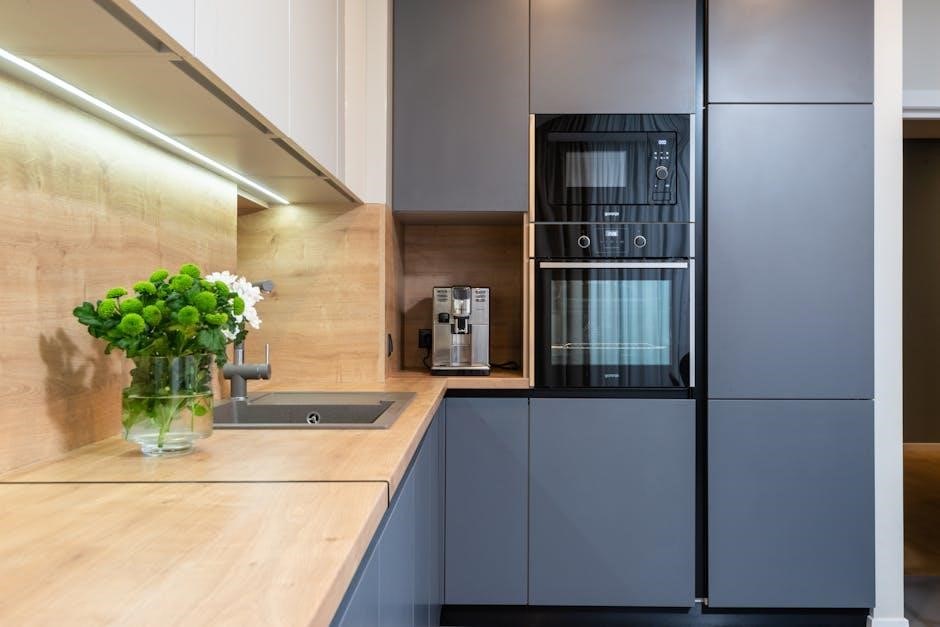
Bosch Built-In Microwave Instructions: A Comprehensive Guide
This guide provides comprehensive instructions for operating your Bosch built-in microwave․ It covers everything from finding your model number to troubleshooting common issues․ Ensure you have the user manual for your specific model handy․ This guide aims to supplement that documentation with helpful tips․
Finding Your Bosch Microwave Model Number
Locating your Bosch microwave’s model number is crucial for accessing the correct user manual and finding specific information about your appliance․ The model number, also known as the E-Nr, is a unique identifier that helps Bosch provide you with accurate support and documentation․
Typically, the model number can be found in several locations․ First, check the front frame of the microwave, often visible when the door is open․ It may be printed on a sticker or plate near the door opening․ Another common location is on the back or side of the microwave․ You might need to pull the microwave out slightly to see this label, but be careful and ensure it is disconnected before moving it․
Additionally, inspect the original packaging or any documentation that came with your microwave․ The model number should be clearly indicated on these materials․ Once you have located the model number, write it down for future reference․ This number will be essential for accessing online manuals, ordering parts, and contacting Bosch customer support if you encounter any issues․ Having the correct model number ensures you get the precise information needed for your specific appliance․
Accessing the Correct User Manual

Once you have located your Bosch microwave’s model number, accessing the correct user manual is the next crucial step․ Bosch provides comprehensive documentation for all its appliances, including valuable information about installation, usage, maintenance, and troubleshooting․
The easiest way to access your user manual is through the official Bosch website․ Navigate to the “Service” or “Support” section and look for a search bar where you can enter your model number․ Once entered, the website will display all available documentation for your specific appliance, including the user manual, installation guide, and any additional information․
Alternatively, you can use online search engines to find your manual․ Simply type “Bosch microwave user manual” followed by your model number․ This often leads to direct links to PDF versions of the manual on the Bosch website or other reliable sources․ Ensure the manual you download matches your model number to avoid incorrect information․
If you prefer a physical copy, you can often download the PDF and print it yourself․ Having the correct user manual at hand will help you understand your microwave’s features, safety precautions, and proper operating procedures, ensuring safe and efficient use․
Understanding Basic Operation: Control Panel Overview
Familiarizing yourself with the Bosch microwave’s control panel is essential for efficient operation․ The control panel typically features a combination of buttons, a digital display, and sometimes a rotary dial, depending on the model․
The digital display shows cooking time, power level, and other relevant information․ Common buttons include “Start,” “Stop/Cancel,” number keys for entering cooking time, and function-specific buttons like “Power Level,” “Defrost,” and “Sensor Cook․” The “Power Level” button allows you to adjust the microwave’s power output, usually ranging from 10% to 100%․
The “Defrost” function is designed to safely thaw frozen food, often requiring you to input the weight of the food for optimal results․ “Sensor Cook” utilizes built-in sensors to automatically adjust cooking time and power level for specific food types, ensuring perfectly cooked meals․
Some models also feature preset cooking programs for popular dishes like popcorn, pizza, or beverages․ Take time to explore the control panel and consult your user manual for detailed explanations of each function․ Understanding these basic operations will enable you to utilize your Bosch microwave effectively and confidently․
Safety Precautions for Bosch Microwaves
Prioritizing safety is crucial when using your Bosch microwave․ Always read the user manual thoroughly before operating the appliance․ Never operate the microwave if the door is damaged, doesn’t close properly, or the seals are compromised․ These issues can lead to microwave leakage, which can be harmful․
Avoid heating liquids or foods in sealed containers, as they may explode․ Use microwave-safe containers and cookware only․ Never use metal containers or utensils inside the microwave, as they can cause sparks and fire․ Be cautious when heating foods with low water content, such as bread, to prevent them from drying out or catching fire․
When heating liquids, use a microwave-safe container with a wide opening and stir the liquid before and after heating to distribute heat evenly․ Do not deep fry in the microwave․ Supervise children when they are using the microwave․ Regularly clean the microwave interior to prevent food buildup, which can cause arcing and damage․
If you notice any unusual sounds, smoke, or burning smells, immediately stop the microwave and unplug it․ Contact Bosch support for assistance from a qualified technician․
Installation Guide for Built-In Models
Installing a Bosch built-in microwave requires careful attention to detail․ Begin by consulting the installation guide specific to your microwave model․ Ensure the designated space meets the required dimensions for proper ventilation and clearance․ Before starting, disconnect the power supply to the area where you will be working․

Carefully unpack the microwave and inspect it for any damage․ Verify that you have all the necessary mounting hardware and brackets included․ Follow the instructions in the installation guide for securing the mounting frame to the cabinet․ Ensure it is level and properly aligned․
Gently slide the microwave into the frame, being careful not to pinch any wires or cables․ Connect the microwave to a properly grounded electrical outlet․ Avoid using extension cords․ Double-check all connections before turning on the power․ Test the microwave to ensure it is functioning correctly․
Finally, attach any trim pieces or panels to complete the installation․ If you encounter any difficulties or are unsure about any step, consult a qualified installer․ Incorrect installation can lead to damage or safety hazards․ Always prioritize safety and precision during the installation process․
Using Sensor Cooking Features
Bosch microwaves often include sensor cooking features that automatically adjust cooking time and power levels for optimal results․ To utilize this feature, first, ensure your microwave is properly installed and connected to a power source․ Refer to your user manual to identify the specific sensor cooking options available for your model․
Prepare your food according to the recipe or package instructions․ Place the food in a microwave-safe dish and cover it appropriately, as directed․ Select the appropriate sensor cooking function from the control panel, such as “Sensor Reheat” or “Sensor Cook․” Input any additional details requested by the microwave, such as the type of food or serving size․
Press the “Start” button․ The microwave will use its sensors to detect the moisture and humidity levels in the food․ Based on this information, it will automatically adjust the cooking time and power level․ Avoid opening the microwave door during the sensor cooking process, as this can disrupt the sensors․

Once the cooking cycle is complete, the microwave will beep․ Carefully remove the food and check its internal temperature to ensure it is properly cooked․ If necessary, you can manually add additional cooking time․ Always follow food safety guidelines when using sensor cooking features․
Defrosting Food Properly
Defrosting food properly in your Bosch microwave is crucial for maintaining food safety and quality․ Before starting, remove any packaging that is not microwave-safe․ Place the frozen food in a microwave-safe dish, ensuring any excess ice or frost is removed․ Refer to your microwave’s user manual to locate the defrost settings․
Most Bosch microwaves have a “Defrost” function․ Select this function on the control panel․ You will typically need to enter the weight of the food item․ This information helps the microwave determine the appropriate defrosting time and power level․ Ensure you input the weight accurately for optimal results․
During the defrosting process, the microwave will cycle on and off․ This prevents the food from cooking while it defrosts․ It is recommended to pause the defrosting cycle periodically to separate the food items, ensuring even thawing․ Remove any pieces that have already thawed to prevent them from overheating․
Once the defrosting cycle is complete, check the food to ensure it is thawed but still cold․ Use the food immediately, or store it in the refrigerator․ Never refreeze food that has been defrosted in the microwave unless it is cooked first․ Always follow food safety guidelines when defrosting food․
Cleaning and Maintenance Instructions
Proper cleaning and maintenance are essential for prolonging the life of your Bosch built-in microwave and ensuring optimal performance․ Always unplug the microwave before cleaning․ Use a soft, damp cloth to wipe down the interior and exterior surfaces․ Avoid using abrasive cleaners, scouring pads, or harsh chemicals, as these can damage the finish․
For stubborn food splatters inside the microwave, heat a cup of water with a few drops of lemon juice or vinegar for a few minutes․ This will create steam that loosens the debris, making it easier to wipe away․ Be cautious when removing the hot cup․
The turntable should be removed and washed regularly with warm, soapy water․ Ensure it is completely dry before placing it back in the microwave․ Inspect the door seals regularly to ensure they are clean and intact․ A damaged or dirty seal can compromise the microwave’s efficiency and safety․
Clean the exterior of the microwave with a mild detergent and a soft cloth․ Stainless steel surfaces can be cleaned with a stainless-steel cleaner to maintain their shine․ Regularly check the vent openings to ensure they are free from dust and debris․ Proper ventilation is crucial for preventing overheating․

Troubleshooting Common Issues
Experiencing issues with your Bosch built-in microwave? Here are some common problems and potential solutions․ If the microwave isn’t heating, first check if it’s properly plugged into a working outlet․ Ensure the door is fully closed and latched, as the microwave won’t operate if the door sensors aren’t engaged․
If the turntable isn’t rotating, make sure it’s correctly placed on the support ring․ Check for any obstructions that might be preventing it from turning freely․ If the microwave is making unusual noises, inspect the interior for any loose objects or debris․
For error codes displayed on the control panel, consult your user manual for specific troubleshooting steps․ Power cycling the microwave (unplugging it for a few minutes and then plugging it back in) can sometimes resolve minor issues․ If the microwave is sparking, immediately stop use and inspect the interior for metal objects or damage to the waveguide cover․
If these troubleshooting steps don’t resolve the issue, it’s best to contact Bosch support or a qualified appliance repair technician․ Attempting to repair the microwave yourself can be dangerous and may void the warranty․
Contacting Bosch Support for Assistance
When troubleshooting your Bosch built-in microwave, there may come a time when you need assistance from Bosch directly․ There are several ways to reach out to their support team for help with your appliance․ Before contacting support, gather your microwave’s model number and serial number․ This information will help the support team quickly identify your specific appliance and provide accurate assistance․
You can find the model and serial number on a sticker located on the microwave itself, often on the interior wall or the back of the unit․ Once you have this information, you can visit the Bosch website to find their customer support contact information․ They typically offer several options for contacting them, including phone support, email support, and online chat․
Phone support is often the quickest way to get immediate assistance, while email support may be better for less urgent inquiries․ Online chat allows you to communicate with a support representative in real-time through your computer or mobile device․ When contacting Bosch support, be prepared to describe the issue you’re experiencing in detail and any troubleshooting steps you’ve already taken․




